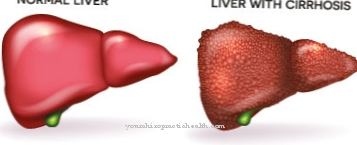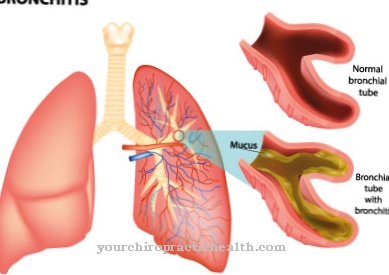At a cerebral vasospasm it is a sudden narrowing of the brain arteries, which is caused by a vascular spasm. This can lead to an insufficient supply of oxygen to the brain. Treatment is often difficult.
What is cerebral vasospasm?
Of the cerebral vasospasm is characterized by a vascular spasm of cerebral arteries. One of the main causes is what is known as subarachnoid hemorrhage. But poisoning, drug abuse and drug consumption can also lead to this vascular spasm. The consequence of cerebral vasospasm can be a cerebral infarction (stroke) due to an insufficient supply of oxygen.
This is referred to as an ischemic stroke in contrast to a hemorrhagic cerebral infarction caused by a cerebral hemorrhage. Cerebral vasospasm can last for weeks and is difficult to treat. The consequences of this vascular spasm depend on its strength.
It can be fatal or cause severe disability. However, more harmless courses are also possible. In subarachnoid hemorrhage, cerebral vasospasm is definitely a serious complication that worsens the prognosis for cerebral hemorrhage.
causes
In most cases, cerebral vasospasm develops as part of a subarachnoid hemorrhage. This results in bleeding from a blood vessel in the arachnoid (cobweb skin) of the brain into the cerebral fluid. The bleeding is usually the result of a congenital vascular malformation in the form of an aneurysm.
The hemolysis of the blood produces substances that presumably induce cramping of the cerebral arteries. Other diseases and poisoning can also lead to vascular spasms in the cerebral arteries. One example is the poisoning with ergot alkaloids (ergotism). Substances like methamphetamines or cocaine also pose a risk.
Therefore, drug or drug abuse often causes cerebral vasospasms. The same applies to medical measures with drug treatment. The exact mechanism by which the vascular spasm develops is not yet known. On the one hand, it is assumed that the substances produced during hemolysis of the blood after subarachnoid hemorrhage cause the arteries to contract.
These substances are prostaglandins and serotonin. They have a vasoconstricting effect. The increased binding of NO through the degradation products of hemolysis is discussed as a further reason. NO (nitrogen monoxide) is known as a vasodilator. The lack of NO promotes the narrowing of the corresponding arteries.
Inflammatory reactions at the site of the bleeding could also contribute to the vasospasm. The subarachnoid hemorrhage already represents a so-called hemorrhagic stroke. The cerebral vasospasm is an additional complication that depends on the amount of blood. In turn, it can lead to secondary ischemic stroke.
Symptoms, ailments & signs
Similar symptoms occur in both the underlying disease and the actual cerebral vasospasm. The main symptom is a devastating headache that can lead to unconsciousness. In addition, there are pathological restlessness, nausea, vomiting, states of confusion, sensitivity to light or noise.
Over a period of several weeks, there are repeated violent headache attacks with annihilating headaches, which are interrupted by less severe headaches. In very severe cases a secondary ischemic stroke with paralysis and other neurological deficits develops.
If cerebral vasospasm occurs as part of a subarachnoid hemorrhage, this usually takes place on the fourth day after the start of the bleeding. In this case, it is a complication that worsens the general condition and prognosis of the patient.
Diagnosis & course of disease
Evidence of cerebral vasospasm can be done via angiography. Angiography is a radiological representation of blood and lymph vessels. Contrast media are injected and X-rays are taken of the blood vessels.
Angiography is currently still superior to CT and MRT examinations in terms of vascular imaging, because it has been carried out for a long time and has therefore been brought to perfection. After a subarachnoid hemorrhage, ultrasound examinations are also performed within the first ten days to quickly identify an impending cerebral vasospasm.
There are no side effects with this method. If all symptoms suggest subarachnoid hemorrhage, but CT scans are inconclusive, a lumbar puncture (removal of cerebral fluid) can be performed. The liquor is then checked for blood.
Complications
Cerebral vasospasm is a complication that can occur in the course of cerebral haemorrhage (subarachnoid haemorrhage), poisoning, drug abuse or certain medical measures. It is a vascular spasm of the arterial cerebral vessels. The corresponding blood vessels contract and endanger the blood supply to the brain.
As a result, certain areas of the brain can die. In this case, it is called a cerebral infarction or ischemic stroke. A cerebral vasospasm therefore always worsens the general condition and the prognosis of the underlying disease. There are diseases with longer phases in which even several cerebral vasospasms can occur.
This applies, among other things, to subarachnoid hemorrhage in the brain. In this case, the spasms are triggered by hemolysis of the blood that has entered the subarachnoid space. However, the contraction of the arteries can only be poorly treated. When there is a risk of cerebral vasospasm, the drug nimodipine is usually used to relax the vascular muscles. This can help prevent vascular spasms.
But that doesn't always work. However, if vasospasm has already occurred, it is advisable to wait until the cramp has resolved on its own. It is usually not possible to predict what possible long-term damage will occur. This depends, among other things, on the strength of the vasospasm, the affected brain regions and the size of the corresponding cerebral infarction.
When should you go to the doctor?
Sudden adverse health effects give cause for concern. A doctor should be consulted if there are changes in behavior or personality within a short period of time. Sensitivity to external stimuli such as light or noise is also a warning signal of the organism. Medical tests are required to clarify the cause. A doctor's visit is therefore necessary as soon as the person concerned experiences changes in their health. Restlessness, nausea, vomiting or dizziness are further signs of an existing illness.
There is a need for action as soon as possible when states of confusion set in, paralysis occurs or unconsciousness occurs. In acute cases, an ambulance service must be alerted and those present must take first aid measures. Failure to do so can result in serious and life-threatening complications. Headaches, a feeling of pressure inside the head as well as disorders of the general functional activity of the organism must be presented to a doctor.
In the event of disorientation or changes in memory, the person concerned needs medical help. A feeling of illness, general malaise or diffuse, inexplicable complaints should also be examined and treated by a doctor. If there is an increase in existing health irregularities or if headaches in particular persist for a long time, a doctor is required. If the person concerned cannot fulfill his usual daily obligations, he should seek medical support.
Treatment & Therapy
Pre-existing cerebral vasospasm is difficult to treat. In most cases, drug treatment with nimodipine is an option. The effectiveness in preventing vasospasm in subarachnoid hemorrhage is best because the drug, as a so-called calcium antagonist, calms the muscle-strong areas of the arteries.
Nimodipine is given in the form of tablets or intravenously. The active ingredient accumulates in the brain due to its fat solubility. However, should cerebral vasospasms occur, there is still the option of using the so-called triple H therapy.
This therapy includes the three points of hypervolaemia, hypertension and hemodilution in order to avoid or reduce the contraction of the arterial blood vessels. In addition, blood flow and blood pressure are increased. Measures to thin the blood are also taken. Very strict control of the procedure is important to minimize the effects on breathing and the circulatory system.
prevention
In many cases, cerebral vasospasm is unpredictable, especially in connection with subarachnoid hemorrhage. These arise on the basis of congenital malformations of arterial blood vessels in the brain. However, hypovolemia and a high blood sugar level are possible risk factors.
In hypovolemia, there is too little blood in the circulation due to blood or fluid loss. High blood sugar levels can contribute to fluid loss due to increased urine output. Therefore, in general, a healthy lifestyle lowers the risk of diabetes as well as the risk of cerebral vasospasm.
Aftercare
Follow-up treatment for cerebral vasospasm is dependent on the underlying condition that led to the condition. If bleeding in the brain was the cause of the cerebral vasospasm, this must be treated sustainably and permanently. In addition to the administration of blood-thinning medication, surgical interventions on the brain may also be necessary.
In addition, regular imaging of the brain by MRI and / or CT should be carried out in order to recognize and treat new abnormalities in the vessels in the brain at an early stage. If you have high blood pressure, it should also be treated with medication to reduce the risk of rebleeding in the brain. Smoking and alcohol consumption must be stopped permanently.
If poisoning has led to the development of cerebral vasospasm, this must be treated and then continuously monitored. Regular checks of the blood values are necessary for this, since renewed poisoning can only be detected in the blood. If drugs or drugs were the cause of the development of the cerebral vasospasm, they must not be consumed under any circumstances.
Medication should be permanently discontinued. It may be necessary to switch to other medication. If there is drug addiction, withdrawal is necessary to prevent cerebral vasospasm from occurring again. In addition, chronic neurological diseases can develop as a result of the cerebral vasospasm, which must be treated separately.
You can do that yourself
In cerebral vasospasm, self-help measures are not enough to initiate recovery or healing. Rather, it is necessary to work with a doctor as soon as the first health impairment occurs.
If there are general functional disorders, irregularities in cognitive processing or a diffuse malaise, it is advisable to consult a doctor. As soon as there are disorders of brain activity, the relationship of trust between the person affected, their relatives and the treating doctor must be strengthened. Sufficient clarification of the existing disorders, their causes and the further course is important. Existing health knowledge should be deepened and expanded. Responsibility for this does not lie with the treating doctors alone.
The patient and their relatives should also independently seek opportunities to expand their basic medical knowledge.In many cases, important decisions about the further course of treatment have to be made within a short period of time. It is therefore particularly important to avoid disputes and disagreements and to work openly and cooperatively with the supervising specialists.
In addition, a healthy lifestyle is generally beneficial for the further course. The diet should be controlled and optimized if possible. In addition, preventive examinations offered in advance should be carried out at regular intervals. This increases the possibility of an early diagnosis.
























.jpg)



